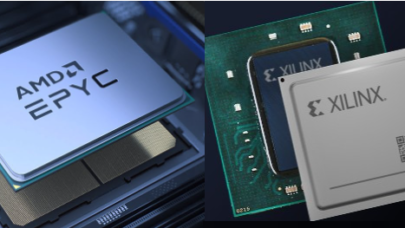
AMD-Xilinx Deal Gains UK, EU Approvals — China’s Decision Still Pending
July 1, 2021
AMD’s planned acquisition of FPGA maker Xilinx is now in the hands of Chinese regulators after needed antitrust approvals for the $35 billion deal were receiv Read more…

The Role and Potential of CPUs in Deep Learning
April 14, 2021
Deep learning (DL) applications have unique architectural characteristics and efficiency requirements. Hence, the choice of computing system has a profound impa Read more…

AMD Partners Unveil Their Plans for Integrating New AMD Epyc CPUs in Servers, Services
March 18, 2021
Now that AMD unveiled its latest third-generation Epyc CPU product line for HPC, enterprise and cloud workloads on March 15, the company’s server and services partners continue to announce their own plans for bringing Epyc-equipped products to market. Read more…

Intel Speeds NAMD by 1.8x: Saves Xeon Processor Users Millions of Compute Hours
August 12, 2020
Potentially saving datacenters millions of CPU node hours, Intel and the University of Illinois at Urbana–Champaign (UIUC) have collaborated to develop AVX-512 optimizations for the NAMD scalable molecular dynamics code. These optimizations will be incorporated into release 2.15 with patches available for earlier versions. Read more…

AMD Launches Epyc Rome, First 7nm CPU
August 8, 2019
From a gala event at the Palace of Fine Arts in San Francisco yesterday (Aug. 7), AMD launched its second-generation Epyc Rome x86 chips, based on its 7nm proce Read more…

Cascade Lake Shows Up to 84 Percent Gen-on-Gen Advantage on STAC Benchmarking
May 13, 2019
The Securities Technology Analysis Center (STAC) issued a report Friday comparing the performance of Intel's Cascade Lake processors with previous-gen Skylake u Read more…

AMD Posts Transitional First Quarter Ahead of Rome Launch
May 2, 2019
On the eve of its 50th anniversary, Advanced Micro Devices (AMD) reported sales of $1.27 billion for Q1 2019, down 10 percent quarter-over-quarter and 23 percen Read more…

Is Amazon’s Plunge into Server Chips a Watershed Moment?
December 11, 2018
For several years now the big cloud providers – Amazon, Microsoft Azure, Google, et al – have been transforming from technology consumers into technology cr Read more…

- Click Here for More Headlines

Whitepaper
Transforming Industrial and Automotive Manufacturing
In this era, expansion in digital infrastructure capacity is inevitable. Parallel to this, climate change consciousness is also rising, making sustainability a mandatory part of the organization’s functioning. As computing workloads such as AI and HPC continue to surge, so does the energy consumption, posing environmental woes. IT departments within organizations have a crucial role in combating this challenge. They can significantly drive sustainable practices by influencing newer technologies and process adoption that aid in mitigating the effects of climate change.
While buying more sustainable IT solutions is an option, partnering with IT solutions providers, such and Lenovo and Intel, who are committed to sustainability and aiding customers in executing sustainability strategies is likely to be more impactful.
Learn how Lenovo and Intel, through their partnership, are strongly positioned to address this need with their innovations driving energy efficiency and environmental stewardship.
Download Now
Sponsored by Lenovo
Whitepaper
How Direct Liquid Cooling Improves Data Center Energy Efficiency
Data centers are experiencing increasing power consumption, space constraints and cooling demands due to the unprecedented computing power required by today’s chips and servers. HVAC cooling systems consume approximately 40% of a data center’s electricity. These systems traditionally use air conditioning, air handling and fans to cool the data center facility and IT equipment, ultimately resulting in high energy consumption and high carbon emissions. Data centers are moving to direct liquid cooled (DLC) systems to improve cooling efficiency thus lowering their PUE, operating expenses (OPEX) and carbon footprint.
This paper describes how CoolIT Systems (CoolIT) meets the need for improved energy efficiency in data centers and includes case studies that show how CoolIT’s DLC solutions improve energy efficiency, increase rack density, lower OPEX, and enable sustainability programs. CoolIT is the global market and innovation leader in scalable DLC solutions for the world’s most demanding computing environments. CoolIT’s end-to-end solutions meet the rising demand in cooling and the rising demand for energy efficiency.
Download Now
Sponsored by CoolIT
Advanced Scale Career Development & Workforce Enhancement Center
Featured Advanced Scale Jobs:
HPCwire Resource Library
HPCwire Product Showcase
© 2024 HPCwire. All Rights Reserved. A Tabor Communications Publication
HPCwire is a registered trademark of Tabor Communications, Inc. Use of this site is governed by our Terms of Use and Privacy Policy.
Reproduction in whole or in part in any form or medium without express written permission of Tabor Communications, Inc. is prohibited.
























